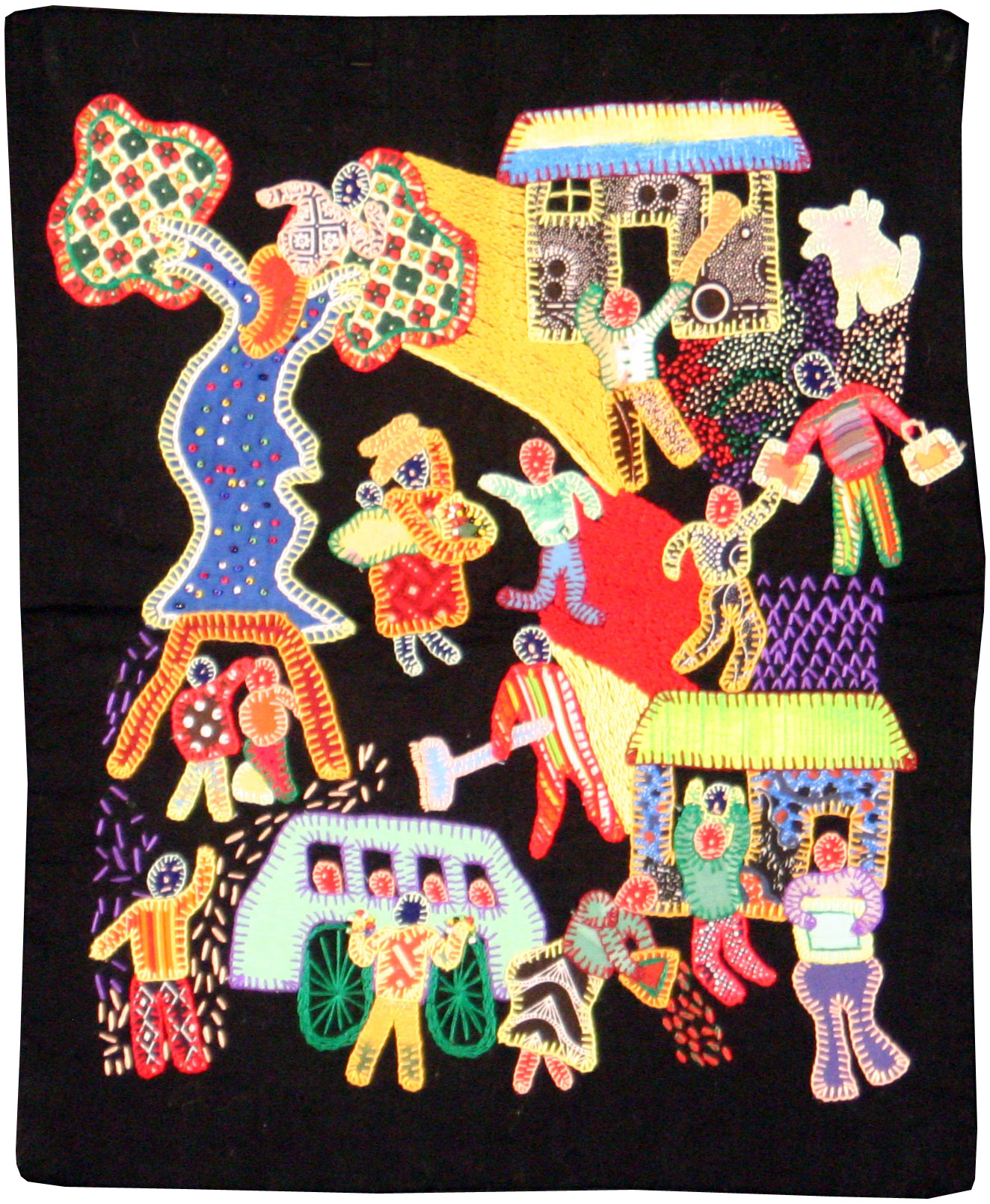
QUILT INDEX RECORD
12-8-5690
Who documented this quilt?
Michigan Quilt Project; Michigan State University Museum Collection; Quilts and Human Rights; South Africa Quilt History Project; The Black Diaspora Quilt History Project
Where are the records for this quilt housed?
Michigan State University Museum
Michigan Quilt Project Number:
10.0182
If this quilt is owned by a museum, enter the accession number:
2010:123.2
Object label:
Xenophobia Memory Cloth
Sheila Mabaso
Newcastle, KWAZulu-Natal, South Africa
2010
Collection of Michigan State University Museum acc.#2010:123.2
Essay:
Sheila Mabaso is a member of the Isiphethu (a Zulu word meaning “Fountain”) group. The Isiphethu began in l999 when a group of women from Madadeni and Osizweni came together to embroider appliqué images for a Woman’s Day project organized by the Carnegie Art Gallery, Newcastle. This project inspired the women to continue creating and a workshop program was launched in 2000. The group continues to work under the umbrella of the gallery and is encouraged to attend mentorship programs where business development and quality control are discussed. They have exhibited nationally and internationally and won many awards.
Sheila Mabaso says of this piece:
Xenophobia is still taking place in some townships. If you are not original from that place or that country, they treat you like a total stranger and they abuse your right of living freely as a human being. Foreigners are doing all the can to survive, they work for very little money, make hand craft to sell, open their small shops. Then the local people get jealous and then they beat them stole in their shops and killed them sometimes. That real unfair.
Quilt's title:
Xenophobia Memory Cloth
Subject of the quilt:
xenophobia
If you are the quilt owner, how did you acquire this quilt?
Received as a gift
Where the quilt was made, city:
Newcastle
Where the quilt was made, province:
KWAZulu-Natal
Where the quilt was made, country:
South Africa
Time period:
2000-2025
When was the quilt finished?
2010
Why was the quilt made?
Personal income
Quilt is presently used as:
Museum collection
Quiltmaker's city:
Newcastle
Quiltmaker's country:
South Africa
Does/did the quiltmaker belong to a group? Name of the group?
Isiphethu (a Zulu word meaning fountain)
Where does/did the group meet?
Newcastle, South Africa.
What are the main activities of the group?
Isiphethu (a Zulu word meaning “Fountain”) began in l999 when a group of women from Madadeni and Osizweni came together to embroider appliqué images for a Woman’s Day project organized by the Carnegie Art Gallery, Newcastle. This project inspired the women to continue creating and a workshop program was launched in 2000. The group continues to work under the umbrella of the gallery and is encouraged to attend mentorship programs where business development and quality control are discussed. They have exhibited nationally and internationally and won many awards. Not only has this project earned the women income but it has given them a voice. They embroider stories of their communal heritage, legends, historical incidents and daily activities. Each woman creates her own design, chooses her own subject, and decides on the colors to fashion fabric ‘storybooks’. Their wall-hangings and tapestries are sold in the Carnegie Art Galleryand are sought after by locals and visitors alike.
This is a:
Finished quilt
How wide is the quilt?
13 3/4"
How long is the quilt?
16 3/4"
Shape of edge:
Straight
Shape of corners:
Straight
What color is the quilt?
Black; Blue; Green; Purple; Red; Yellow; White
Antique colors:
Claret or Wine
Quilt's condition:
Excellent/like new
Type of inscription:
Message
What is inscribed on the quilt?
isiphethu Original African Creations Hand Embroidered & Made in South Africa
Describe the quilt's layout:
Wholecloth
Number of quilt blocks:
1
Fiber types used to make the quilt top:
Cotton
Piecing techniques used to make the quilt top:
Machine Piecing
Applique techniques used to make the quilt top:
Hand Applique
Embellishment techniques used to make the quilt top:
Attachments (beading, charms, buttons, etc); Embroidery
Embellishments used:
Cotton thread
Materials used to make the back:
Cotton
How is the binding made?
Edges turned in/ no separate binding
What kind of filling is used in the quilt?
No filling
How are the layers held together?
Not quilted
Features or notes about the quilt's appearance, materials, or construction:
'Xenophobia S. Mabaso Xenophobia is still taking place in some townships. If you are not original from that place or that country, they treat you like a total stranger and they abuse your right of living freely as a human being. Foreigners are doing all the can to survive, they work for very little money, make hand craft to sell, open their small shops. Then the local people get jealous and then they beat them stole in their shops and killed them sometimes. That real unfair. Memory cloth made by S. Mabaso in South Africa. Small colorful wallhanging on black cotton ground. Embroidery and applique on the cloth depict a scene in a township neighborhood with people gesturing at each other. One man is waiving a club. Houses and a vehicle are depicted.
Where did the maker find their pattern?
Original to maker
Source of the information on this quilt:
Museum employee
Ownership of this quilt is:
Public- Michigan State University Museum
Quilt owner's name:
Michigan State University Museum
Quilt owner's city:
East Lansing
Quilt owner's county:
Ingham
Quilt owner's state:
Michigan (MI)
Quilt owner's country:
United States
How was this quilt acquired?
Purchase
Access and copyright information:
Restricted
Who photographed this quilt?
Pearl Yee Wong
Copyright holder:
MSU Board of Trustees
Cite this Quilt
Xenophobia Memory Cloth. 2010. From Michigan State University Museum, Michigan Quilt Project; Michigan State University Museum Collection; Quilts and Human Rights; South Africa Quilt History Project; The Black Diaspora Quilt History Project. Published in The Quilt Index, https://quiltindex.org/view/?type=fullrec&kid=12-8-5690. Accessed: 04/26/24
-
Collection
International Collection from the Mich...
MacDowell, Marsha